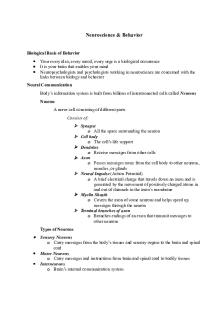Chapter 2 Neuroscience and Behavior PDF

| Title | Chapter 2 Neuroscience and Behavior |
|---|---|
| Author | Michael Clarity |
| Course | Introduction to Psychology |
| Institution | Drexel University |
| Pages | 3 |
| File Size | 172 KB |
| File Type | |
| Total Downloads | 18 |
| Total Views | 150 |
Summary
Neuroscience and Behavior...
Description
Neuroscience & Behavior
Biological Basis of Behavior
Your every idea, every mood, every urge is a biological occurrence It is your brain that enables your mind Neuropsychologists and psychologists working in neuroscience are concerned with the links between biology and behavior
Neural Communication Body’s information system is built from billions of interconnected cells called Neurons Neuron A nerve cell consisting of different parts Consists of:
Synapse o All the space surrounding the neuron Cell body o The cell’s life support Dendrites o Receive messages from other cells Axon o Passes messages away from the cell body to other neurons, muscles, or glands Neural Impulse (Action Potential) o A brief electrical charge that travels down an axon and is generated by the movement of positively charged atoms in and out of channels in the axon’s membrane Myelin Sheath o Covers the axon of some neurons and helps speed up messages through the neuron Terminal branches of axon o Branches endings of an exon that transmit messages to other neurons Types of Neurons
Sensory Neurons o Carry messages from the body’s tissues and sensory organs to the brain and spinal cord Motor Neurons o Carry messages and instructions from brain and spinal cord to bodily tissues Interneurons o Brain’s internal communication system
Neurotransmitters Chemicals that:
Are released from the sending neuron and travel across the synapse Then they bind receptor sites on the receiving neuron, thereby influencing it to trigger or inhibit an action potential
Examples: o Serotonin Affects mood, hunger, sleep, and arousal Undersupply can lead to depression o Norepinephrine Helps control alertness and arousal Undersupply can lead to depression
The Nervous System Nervous System Consists of all the nerve cells. It is the body’s speedy, electrochemical communication system Central Nervous System (CNS) The brain and spinal cord Peripheral Nervous System (PNS) The sensory and moto neurons that connect the central nervous system to the rest of the body
The Cerebral Cortex
The body’s ultimate control and information-processing center Divided into two hemispheres (Left and Right) o Each hemisphere controls the opposite side of the body o Motor functions exercise
Structure of the Cortex Each brain hemisphere is divided into four lobes that are separated by prominent fissures 1) Frontal lobe (Forehead) a. Conscious thought, executive processing, higher order functions 2) Parietal Lobe (Top to Rear Head) a. Visual-spatial processing, sensory integration 3) Occipital Lobe (Back Head) a. Sense of sight; location of visual cortex 4) Temporal Lobe (Side of Head) a. Sense of hearing; location of auditory cortex Functions of the Cortex Motor Cortex The area at the rear of the frontal lobes that control voluntary movements Sensory Cortex (Parietal Cortex) Receives information from skin surface and sensory organs Right-Left Differences
The myth of Right-brained vs Left-Brained o States that left-brained individuals are more logical, methodical, and analytical, while right-brained individuals are more creative and artistic o Each of the hemispheres perform distinct functions, but we use our whole brains Right hemisphere = Perceptual tasks Left hemisphere = Speaking, Calculations
Viewing inside the Brain
EEG (electroencephalogram) o Records brain waves PET (Positron emission tomography) o Depicts brain activity by showing brain area’s consumption of glucose (its chemical fuel) MRI (Magnetic resonance imaging) o Uses magnets to provide a detailed picture of soft tissues Functional MRI o Illustrates blood flow in the brain as people perform certain mental activities Using fMRI to predict behavior...
Similar Free PDFs

Neuroscience Chapter Notes
- 46 Pages

Purve Neuroscience - Chapter Notes
- 14 Pages

Quiz 2 Neuroscience
- 2 Pages

Chapter 10 Neuroscience
- 18 Pages

Neuroscience Exam 2 Content
- 12 Pages

Neuroscience Part 2 Lecture 7
- 3 Pages

N8 - neuroscience
- 4 Pages

Social Neuroscience
- 6 Pages
Popular Institutions
- Tinajero National High School - Annex
- Politeknik Caltex Riau
- Yokohama City University
- SGT University
- University of Al-Qadisiyah
- Divine Word College of Vigan
- Techniek College Rotterdam
- Universidade de Santiago
- Universiti Teknologi MARA Cawangan Johor Kampus Pasir Gudang
- Poltekkes Kemenkes Yogyakarta
- Baguio City National High School
- Colegio san marcos
- preparatoria uno
- Centro de Bachillerato Tecnológico Industrial y de Servicios No. 107
- Dalian Maritime University
- Quang Trung Secondary School
- Colegio Tecnológico en Informática
- Corporación Regional de Educación Superior
- Grupo CEDVA
- Dar Al Uloom University
- Centro de Estudios Preuniversitarios de la Universidad Nacional de Ingeniería
- 上智大学
- Aakash International School, Nuna Majara
- San Felipe Neri Catholic School
- Kang Chiao International School - New Taipei City
- Misamis Occidental National High School
- Institución Educativa Escuela Normal Juan Ladrilleros
- Kolehiyo ng Pantukan
- Batanes State College
- Instituto Continental
- Sekolah Menengah Kejuruan Kesehatan Kaltara (Tarakan)
- Colegio de La Inmaculada Concepcion - Cebu







